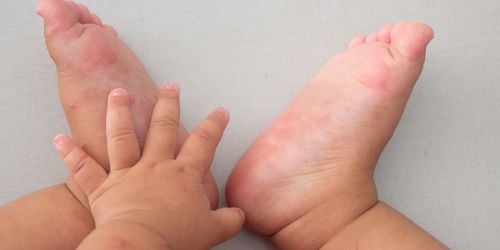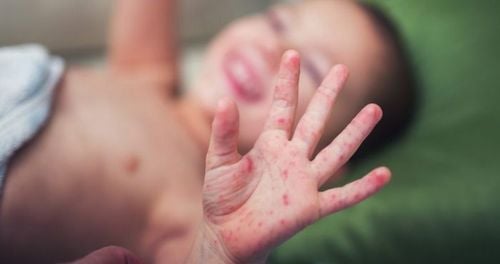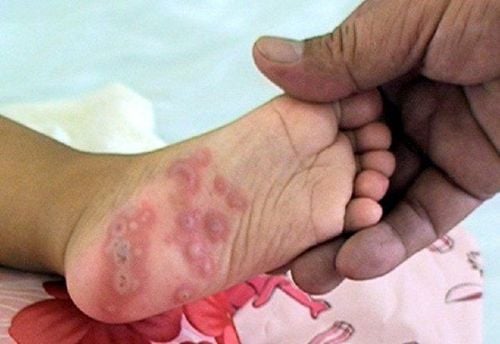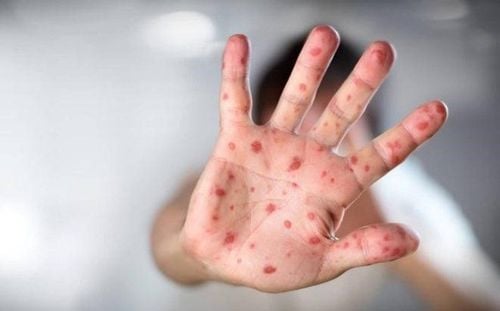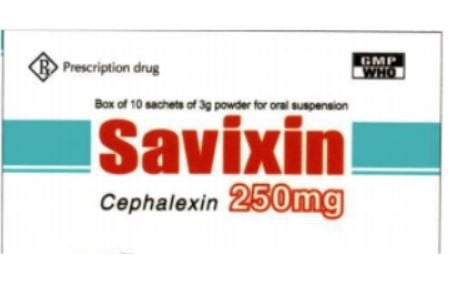This is an automatically translated article.
Hand, foot and mouth disease in infants, caused by one of the groups of coxsackie viruses, is a benign and self-limiting disease. Hand, foot and mouth disease is most common in children under 4 years of age, with typical symptoms being small sores on their hands and feet, and in their mouths.1. Hand, foot and mouth disease in children
As a disease that is easily transmitted from person to person, hand, foot and mouth disease in children often breaks out quickly in families and places with many young children, such as children's play areas and kindergartens.
Newborns get hand, foot and mouth disease if an infected person coughs or sneezes near the baby, or from contact with the patient's stool, saliva, or fluid from the patient's blister sores. For a case of illness, the most contagious period is before symptoms appear. Therefore, it is difficult to detect and isolate in time, completely prevent the disease for babies.
It is necessary to distinguish hand, foot and mouth disease in infants as a completely different disease from foot-and-mouth disease - an epidemic affecting farm animals.
2. Hand, foot and mouth symptoms in infants
The most obvious symptom of hand, foot and mouth disease in infants is blisters on the skin. But before the blisters appear, babies may also have a sore throat, fever, and abdominal pain. After a few days, parents will notice the following features:
Mouth: Red spots appear on the baby's tongue and inside the mouth. These spots will gradually turn into larger, grayish-yellow blisters with red borders. Hands and feet: Small red raised spots appear on your baby's fingers, back or palms, soles, and toes. These spots can be painful and itchy, then turn into gray blisters in the middle. The blisters above look like a red, blistering rash that swells and scalds, and sometimes spreads to an infant's legs, buttocks, and groin. Children with the disease may have poor appetite (if the baby is in the weaning stage) or stop feeding because the blisters in the mouth cause swelling, pain, and discomfort.
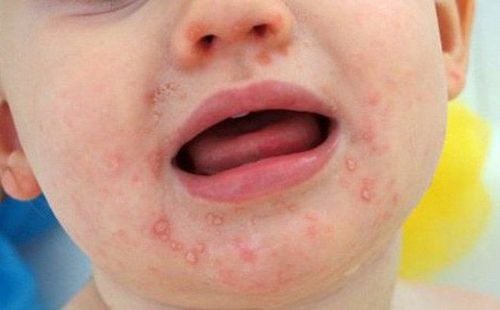
Xuất hiện những đốm đỏ trên lưỡi và bên trong miệng của bé khi bị tay chân miệng
3. Diagnosis and treatment of hand, foot and mouth disease in infants
To diagnose hand, foot and mouth disease in infants, the doctor will ask about your baby's symptoms and check for sores or rashes. Sometimes additional viral testing with a throat swab or stool or blood sample is needed to be sure.
It will take about a week to 10 days for the rash to disappear completely and other accompanying symptoms to subside. During this time, babies can be very upset and often fussy. Parents should refer to how to care for children with hand, foot and mouth disease as follows:
Baby has pain when eating or sucking: Eat smaller meals and increase the frequency of eating more often. You can continue to breastfeed because the blisters on your baby's mouth won't pass through your nipples and make you sick. For babies using formula milk, they should add extra water.
Baby solids: Give your baby soft foods that are easy to swallow, such as mashed potatoes or soup. Do not let your baby eat spicy foods or drink sour juices as this can increase the pain in the mouth.
Teething Pain Relief Gel: This gel can be used to soothe the pain caused by blisters in the baby's mouth after consulting the pharmacist at the pharmacy. Rub a little gel on sores on your baby's gums, tongue and inside cheeks.
Fever reducers: Paracetamol or ibuprofen for babies can help relieve pain and reduce fever. Parents can give infants 2 months and older paracetamol if the baby is not premature and weighs more than 4kg. Use ibuprofen if your baby is 3 months or older and weighs at least 5kg. It is important to carefully read the manufacturer's instructions on the package and ask your doctor/pharmacist for advice on the most appropriate dose of pain reliever and fever reducer for your child.
Gently wash: When bathing your baby, it is important to remember to wash gently because the damaged skin can be very painful. Try not to burst any of your baby's blisters to avoid leaking fluid causing an infection.
Isolation and rest: If the infant has gone to daycare or has been sent to childcare, parents should keep the child at home until the baby recovers and gets better. Sometimes babies don't need to be completely isolated until the sores go away, but it's a good idea to talk to a teacher or babysitter before sending your baby back to school.
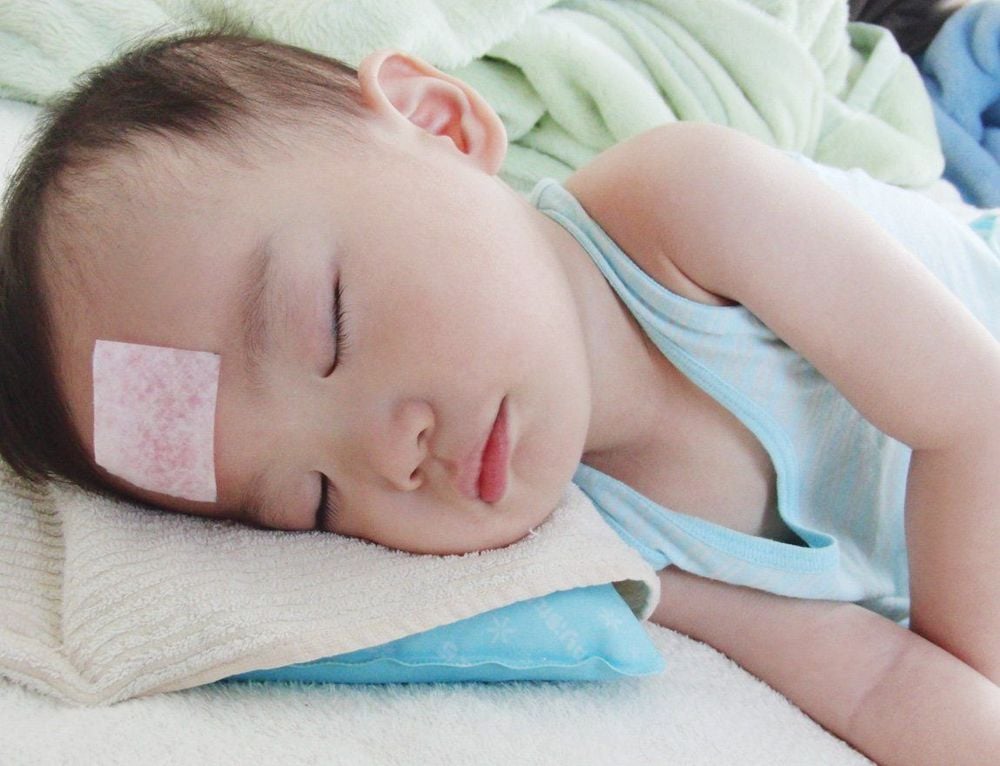
Dùng thuốc hạ sốt cho trẻ với liều theo cân nặng nếu trẻ bị sốt
4. When should I take my baby to the doctor?
Parents do not need to bring their newborn baby with hand, foot and mouth disease to the hospital right away because the disease will go away on its own after all stages have passed. Hand, foot and mouth disease in children cannot be treated with antibiotics because the cause is a virus.
But sometimes hand, foot and mouth in babies causes some more serious problems that require the intervention of a doctor. For example, an infant can become dehydrated if the symptoms make him too uncomfortable and not drinking enough fluids. Children should be taken to the doctor if they detect the following signs:
Lethargy and lethargy; Crying, stirring; Diapers drier than usual due to less urination; Dark yellow urine; Cold hands and feet; Continuous high fever (≥ 38 degrees C for babies under 3 months old and ≥ 39 degrees C for babies 3 to 6 months old). Although quite rare, hand, foot and mouth sores can become infected (secondary infection) and require antibiotic treatment to clear up the bacteria as ordered by your doctor. The baby should be taken to the hospital immediately if the following signs of secondary infection are detected:
The baby's skin becomes very painful, red, swollen and hot; The blisters begin to ooze yellow pus instead of clear liquid; Symptoms become more severe, do not improve or improve after 7-10 days. When your baby's skin begins to peel, it's a sign that the sores are healing and the infant is feeling better. However, you should wear gloves and socks to prevent your baby from scratching, and combine with soft skin cream to soothe the baby's skin.
In some cases, infants and children lose fingernails or toenails several weeks after the illness is over, especially if large blisters have been present. This can make many parents panic, but there is no need to worry because the baby's nails will grow back on their own without medical intervention.
Pediatrics department at Vinmec International General Hospital is the address for receiving and examining diseases that infants and young children are susceptible to: viral fever, bacterial fever, otitis media, pneumonia in children, .... With modern equipment, sterile space, minimizing the impact as well as the risk of disease spread. Along with that is the dedication from the doctors with professional experience with pediatric patients, making the examination no longer a concern of the parents.
Please dial HOTLINE for more information or register for an appointment HERE. Download MyVinmec app to make appointments faster and to manage your bookings easily.
5. Recurrence of hand, foot and mouth disease in children
After recovering from hand, foot and mouth disease, the newborn will be immune to certain strains of the virus that he or she has contracted. However, just like the cold virus, there are many strains of the coxsackie virus and your baby will be more likely to relapse.
To protect babies from getting hand, foot and mouth again, parents should pay attention to hygiene for children by:
Covering mouth with tissue when coughing and sneezing, discarding after one use; Handle diapers properly because the virus can still exist in the baby's stool 1-2 months after the illness has been cured; Make sure to keep the toilet clean; Avoid sharing personal items, such as cups or towels, .... In particular, frequently use soap and water to wash your baby's hands, as well as the hands of the caregiver, most importantly at times the following points:
Before and after changing diapers; After going to the toilet; Before giving breast milk or bottle milk; Before mealtime with babies who have started to eat solids; After touching your baby's used personal belongings. In terms of the risk of harm to the fetus when a woman has hand, foot and mouth disease, doctors say that adults may be immune to different strains of the coxsackie virus. Even if a pregnant woman has hand, foot and mouth disease, the symptoms are usually very mild and the fetus will not be affected. However, if a pregnant woman develops HFMD just a few weeks before giving birth, she should report it to her obstetrician for follow-up because there is still a small risk of developing hand, foot, and mouth disease in the infant.




